Sep 4, 2018
Go Deep! Football is America’s Favorite Sport, and a Money-Making Machine
Football has its issues, but it’s still an economic powerhouse.

The end of summer, for many people, generally means a few things: Back-to-school sales, Labor Day barbecues, and putting the finishing touches on your fantasy football roster. And while not everyone is a football fan, it’s arguably America’s favorite sport.
The National Football League (NFL) is viewed favorably by 57% of Americans, and 37% say it’s their favorite sport to watch, far more than any other sport, according to recent survey data from Gallup. There’s clearly demand for bone-crunching hits, pick-sixes, and 60-yard field goal attempts among U.S. consumers.

And where there’s demand, there’s an opportunity to make money. And when it comes to football, there’s an awful lot of it to be made.
Footballconomics
Football’s two primary economic engines in the U.S. are the NFL and college football, and the two generate billions in revenue:
- $14 billion—Total NFL revenue in 2017.
- $31.9 million—Average revenue per FBS NCAA football team/school (129 total, as of 2018).
How football makes money
Billions of dollars flow through the football economy every year from sources including merchandising and endorsement deals. But the bulk is driven through sales of broadcasting rights.
The complete financials for leagues like the NFL are private, but we do know some details regarding the NFL’s media revenues:
- Fox Sports will pay the NFL $3 billion to broadcast “Thursday Night Football” for five years.
- Verizon will pay the NFL $1.5 billion to stream games to subscribers for five years.
- The NFL has TV broadcast contracts with CBS, ESPN, Fox, and NBC that expire in 2022.
College football
College football is played between U.S. universities and colleges (with one exception). There are 777 schools, around the country, in various divisions, that field football teams. The college game is played at four levels, or divisions (the biggest and most popular being the Football Bowl Subdivision, FBS), under the National Collegiate Athletic Association (NCAA).
College football players are technically amateurs—they aren’t paid, and instead, most players are granted athletic scholarships and room and board by their college or university—the college game generates massive revenues.
All college sports combined (including basketball, baseball, and other sports) generated $1.06 billion in 2017, the most ever. Football is responsible for the majority of it.
College football works differently than the NFL, as groups of schools, or conferences, negotiate together for better deals. These are the average payouts for broadcasting rights, per school, in each of the “Power 5” FBS conferences in 2017:
- Southeastern Conference (SEC)—$40.9 million
- Big Ten—$35 million
- Big 12—$35 million
- Pac-12—$29 million
- ACC—$27 million
While these revenues come primarily from broadcasting rights, football groups also generate money from licensing deals, video games, sponsorships, and equipment agreements. For example, Nike inked a deal with the NFL to supply all on-field equipment, to all 32 teams, until 2028. The NFL is also partnering with sports merchandise company Fanatics to sell replica jerseys and gear in retail stores.
College teams negotiate their own deals on a per-school basis, and they vary wildly in value. The most valuable current agreement, between the UCLA and Under Armour, nets the school nearly $13 million per year until 2032.
Adding it all up
What does all of that revenue add up to? Valuable franchises. Here are the most valuable NFL teams in the league, according to Forbes:
| NFL Team | Value |
|---|---|
| Dallas Cowboys | $4.8 billion* |
| New England Patriots | $3.7 billion |
| Washington Redskins | $3.1 billion |
| San Francisco 49ers | $3.05 billion |
| Los Angeles Rams | $3 billion |
And here are the most valuable college football programs, according to the Wall Street Journal:
| NCAA Team | Value |
|---|---|
| Ohio State | $1.5 billion |
| Texas | $1.2 billion |
| Oklahoma | $1 billion |
| Alabama | $930 million |
| Louisiana State (LSU) | $910 million |
While college football players don’t get paid to play, the NFL has some of the world’s highest-paid athletes, when accounting for salary and endorsement deals, according to recent data from Forbes:
- $67.3 million per year–Matt Ryan, quarterback for the Atlanta Falcons
- $59.5 million per year–Matthew Stafford, quarterback for the Detroit Lions
- $42.9 million per year–Drew Brees, quarterback for the New Orleans Saints
- The average NFL player earns $2.1 million per year, and the league minimum is $500,000 per year.
The game has issues, however.
While football has proven to be a money-maker, the sport faces a slew of on and off-the-field issues.
The NCAA, for example, has been criticized for earning hundreds of millions of dollars while players remain unpaid—and if there’s a change to the existing model, college football as we know it may cease to exist.
The NFL, likewise, is being dragged into political battles, and dealing with recent revelations concerning the long-term effects of playing the game. Specifically, many former players develop brain damage, creating questions about how safe the game truly is.
Despite the game’s controversies, it continues to captivate millions of Americans. And if you’re a football fan and want to get in on the action, you can put your money in the field by investing in companies that operate in and around the game on Stash.
*Dallas Cowboys are considered the most valuable sports franchise worldwide.
Related Articles

15 Largest AI Companies in 2024

The 12 Largest Cannabis Companies in 2024

What Is a Traditional IRA?

Saving vs. Investing: 2 Ways to Reach Your Financial Goals

How To Invest in the S&P 500: A Beginner’s Guide for 2024

Stock Market Holidays 2024





